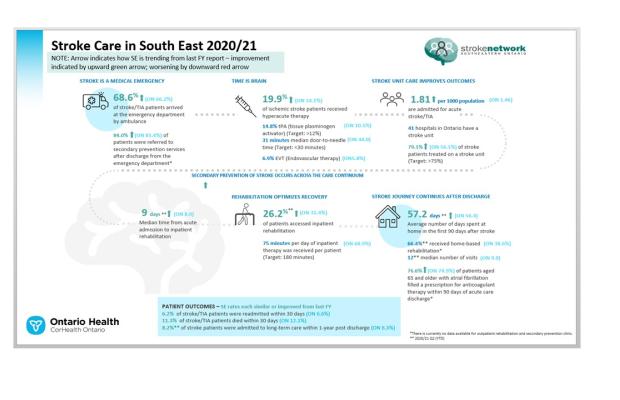
“The entire region is to be congratulated on the stroke care improvements seen in each sector of care; every indicator showed positive change in our regional report!” Dr. Al Jin, Stroke Neurologist and Medical Director, Stroke Network of Southeastern Ontario.
A recently released Ontario Stroke Report indicates that patient and families from across the Southeastern Ontario are benefiting from ongoing improvements to care. The Regional Stroke Evaluation Infographic indicates improvement in EVERY indicator. The region was a high performer in access to hyperacute treatment, stroke prevention clinics, stroke unit care and home-based community rehabilitation. Improvements were also seen in areas that have been more challenging in the past such as calling 911 to access emergency care, anticoagulation rates for those discharged with atrial fibrillation and flow to inpatient rehabilitation. Over the summer, meetings were held with stroke teams to review local evaluation reports and infographics from the Central KFLA, East LLG and West HPE areas. During these meetings, stroke teams provided Stroke Network leaders with suggestions on how care could continue to be improved over coming years, informing our future workplan.
The Stroke Network of Southeastern Ontario is committed to working with stroke survivors, families and all partners to continuously improve the system of stroke prevention and care in this region. Working as one team, we will continue to improve patient care outcomes and recovery! Thank you to every person contributing to excellence in stroke care!
LEARN MORE – link to what’s new.
WHAT’S NEW: Slightly longer summary (ie, a short paragraph) – also include or clarify any hyperlinks to the website you would like added – including “Learn More”
“The entire region is to be congratulated on the stroke care improvements seen in each sector of care; every indicator showed positive change in our regional report!” Dr. Al Jin, Stroke Neurologist and Medical Director, Stroke Network of Southeastern Ontario.
A recently released Ontario Stroke Report indicates that patient and families from across the Southeastern Ontario are benefiting from ongoing improvements to care. The Regional Stroke Evaluation Infographic indicates improvement in EVERY indicator. The region was a high performer in access to hyperacute treatment, stroke prevention clinics, stroke unit care and home-based community rehabilitation. Improvements were also seen in areas that have been more challenging in the past such as calling 911 to access emergency care, anticoagulation rates for those discharged with atrial fibrillation and flow to inpatient rehabilitation. Over the summer, meetings were held with stroke teams to review local evaluation reports and infographics from the Central KFLA, East LLG and West HPE areas. During these meetings, stroke teams provided Stroke Network leaders with suggestions on how care could continue to be improved over coming years, informing our future workplan. In September, letters were sent to CEOs of each designated stroke care hospital thanking them for their leadership in improving stroke care within the region and within their local community.
Some key stroke care findings are summarized below.
- Strengths to sustain - performance above provincial rates:
- ED Referral Rate of TIA patients to Stroke Prevention Clinics (SPC);
- Ambulance use – percent calling 911 to access emergency care;
- Top performer in access to hyperacute treatment and door-to-needle times;
- Region-wide access to Designated/Acute Stroke Units;
- Region-wide access to Home-Based Community Stroke Rehabilitation;
- Stable outcomes – 30-day mortality, 30-day readmission, rate of LTC admission within a year.
- Challenges - though improving, performance remains below provincial rates:
- Stroke Prevention with high stroke admission rates and low anticoagulation rates in rural areas;
- Flow to inpatient rehabilitation measured by time from stroke onset to rehabilitation admission;
- Region-wide access to designated rehabilitation beds;
- Persisting alternate level of care (ALC) rates.
- Known system gaps identified at local meetings:
- Lack of comprehensive neuro outpatient rehabilitation services in Kingston and Brockville;
- Lack of standardized outpatient monitoring data for Stroke Prevention Clinics and Outpatient Rehabilitation;
- Delayed access to thrombolysis in LLG given patients must be transported to Kingston or Ottawa;
- Challenges in Health Human Resources with an ongoing need to build and sustain stroke expertise.
The Stroke Network of Southeastern Ontario is committed to working with stroke survivors, families and all partners to continuously improve the system of stroke prevention and care in this region. Working as one team, we will continue to improve patient care outcomes and recovery! Thank you to every person contributing to excellence in stroke care!
Your local area stroke report card and local infographic can be obtained by visiting the Performance section of our website.
LEARN MORE Performance | Stroke Network of Southeastern Ontario (strokenetworkseo.ca)


